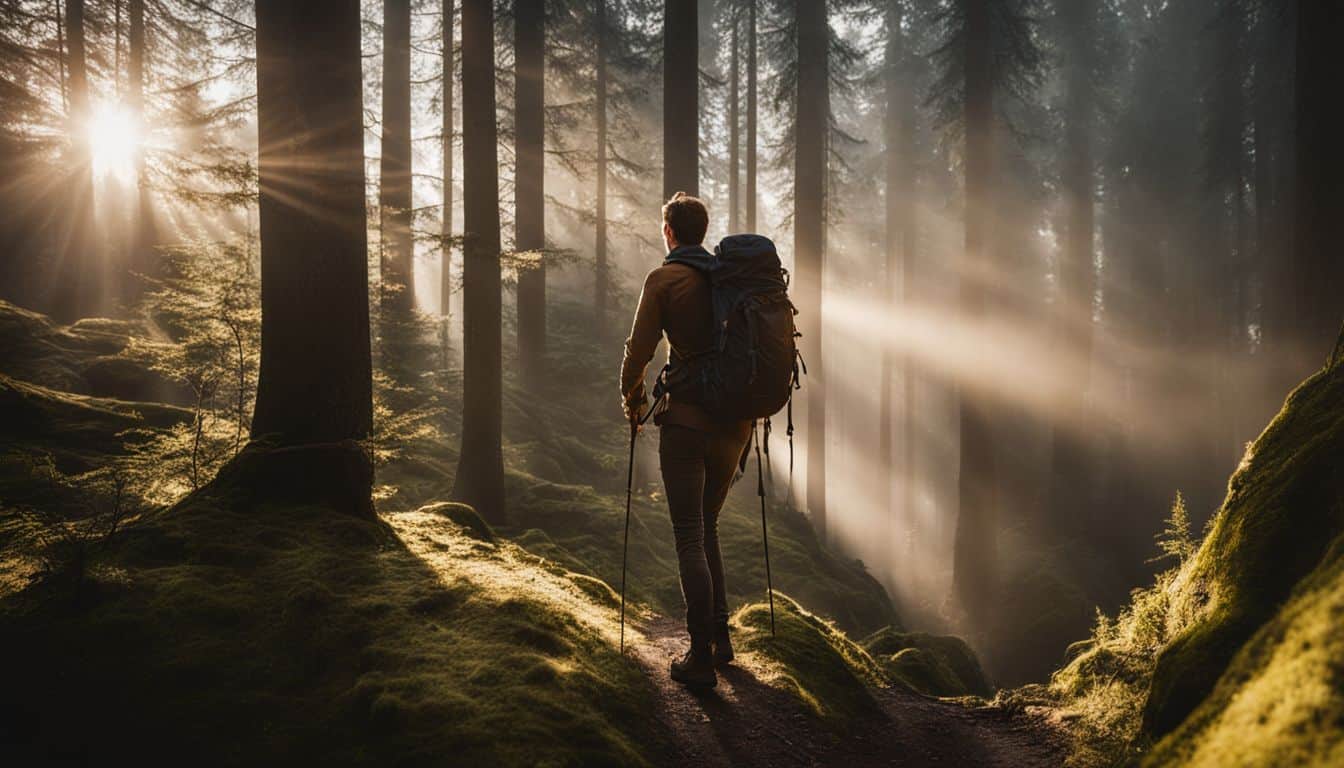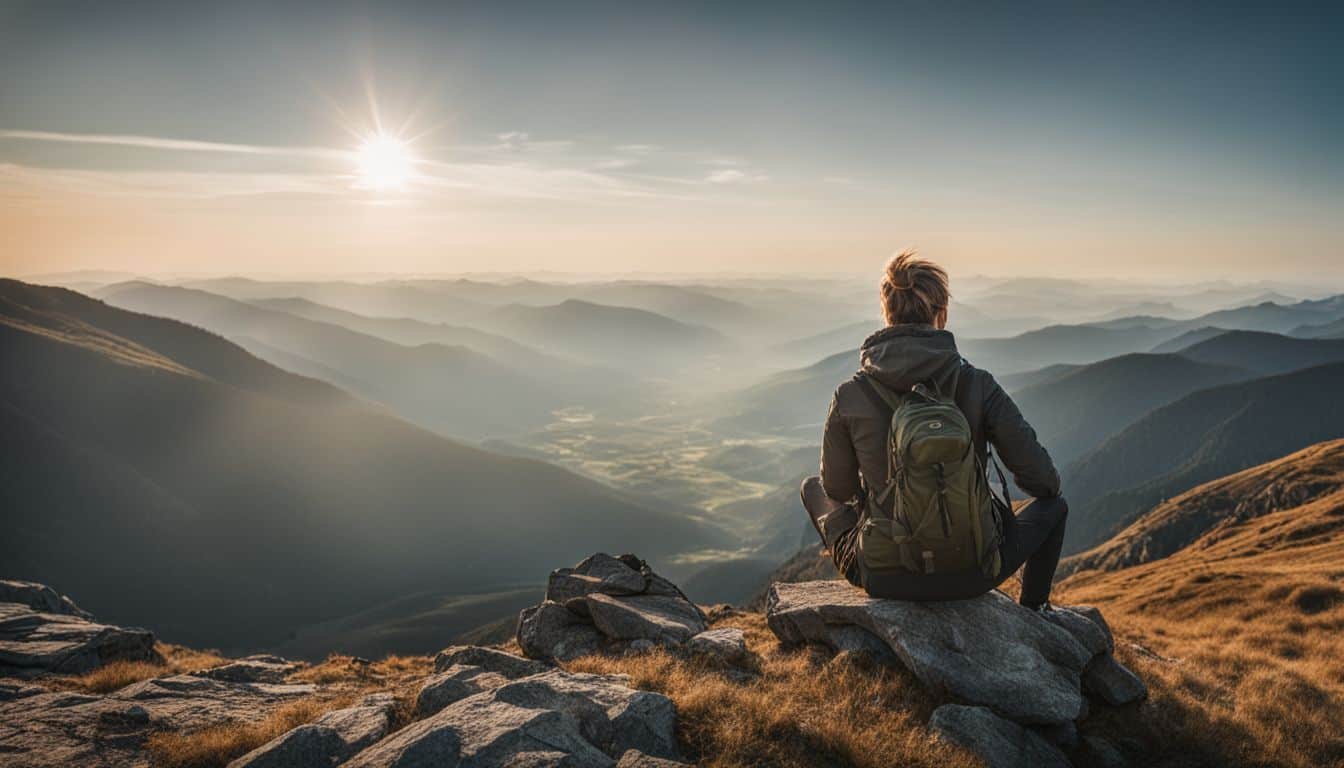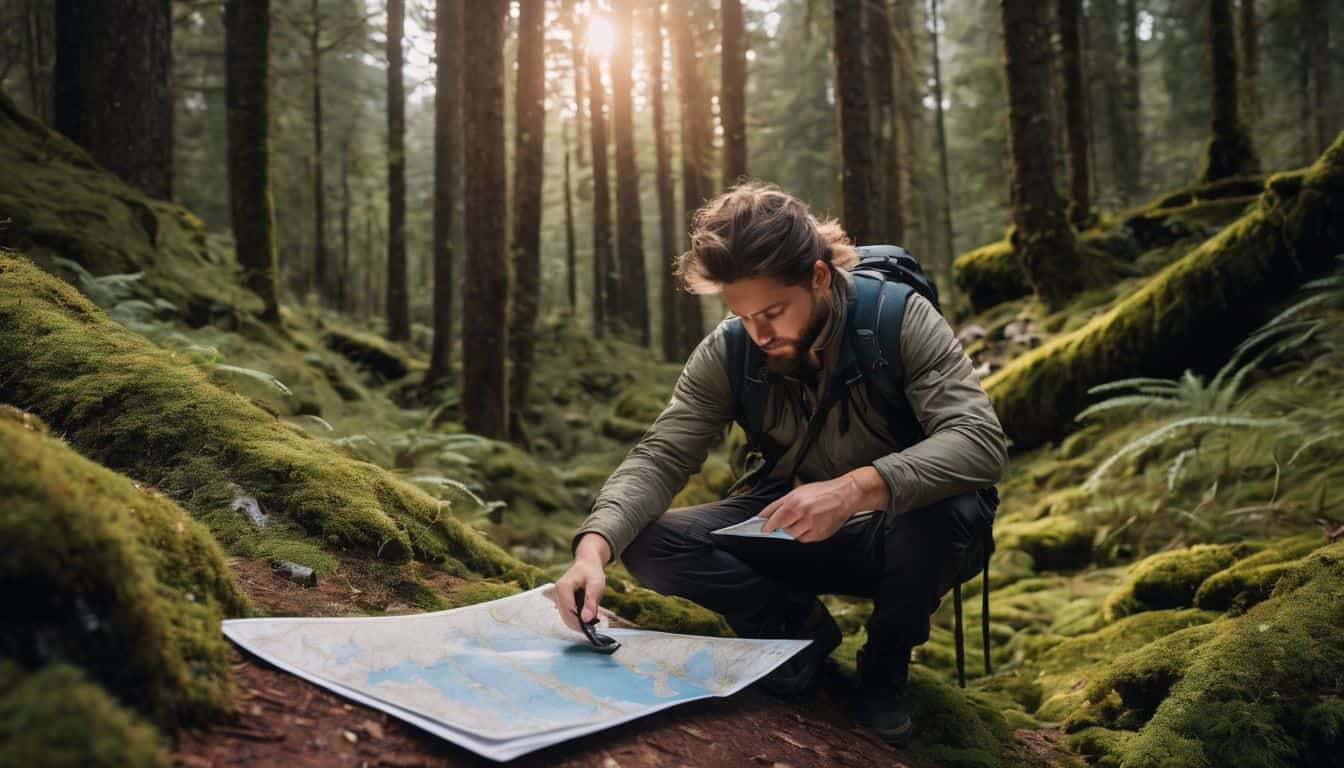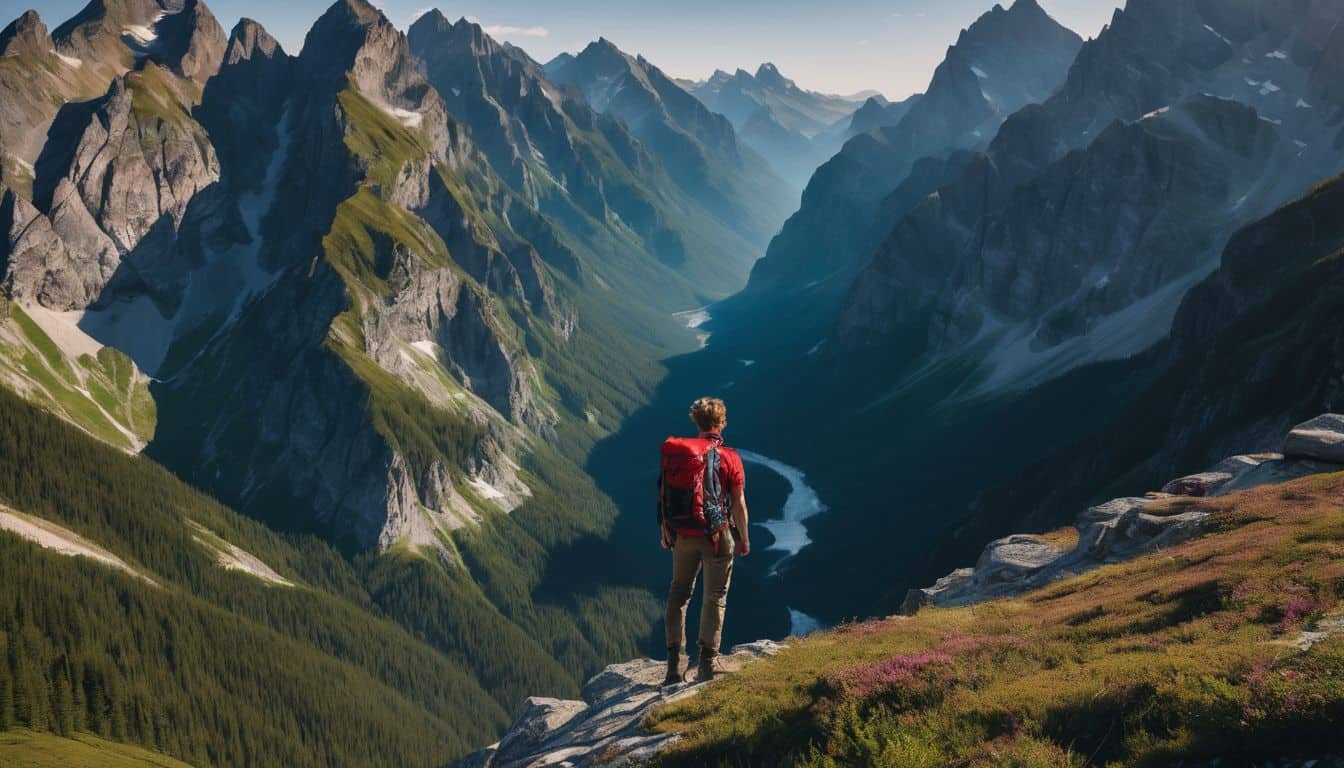Navigating the great outdoors can stir up quite the adventure, and just like you, I’ve grappled with finding my way in landscapes that felt more like mazes than serene retreats. The uncertainty occasionally had me on edge – a feeling no true adventurer wants to get acquainted with.
That’s why I decided to take a deep dive into researching natural navigation methods, transforming Mother Nature into a trusty guide rather than an enigma. So stick around as we delve into five reliable ways of using nature’s own signal system for orientation – promising you’ll never experience that lost-in-the-wilderness feeling again!
Key Takeaways
- Natural navigation is a way of finding your path using nature’s own signals, like the sun, stars, and moss on trees.
- To navigate naturally, orient yourself to large landmarks, stay aware of your surroundings to avoid getting lost, use handrails like rivers or roads for guidance, and gather as many clues as possible from the environment.
- You can navigate using the sun by observing shadows, using your hand as a guide, making a sun compass with a stick and measuring its shadow over time. In the Northern Hemisphere, you can also find direction by noticing the position of the sun throughout the day and looking for vegetation leaning towards south.
- The stars can be used for navigation too. Polaris (North Star) helps locate north in the Northern Hemisphere while the Southern Cross points to due south in the southern hemisphere.
What is Natural Navigation?
Natural Navigation is a cool way of finding our path using what’s around us. It can be the sun, stars, and even moss on trees! This age-old method lets people know their place in the world.
It doesn’t need any tools like maps or compasses. You just use your eyes and mind to read natural signs.
In this skill, we learn to tell direction from the sun’s spot in the sky. We also study how stars move at night for clues. The shape of land and where plants grow can help too! Some people even watch animals because they often follow paths that lead to food and water sources.
Natural navigation turns every trip into an exciting game of reading Mother Nature’s signposts!
So let’s dive deeper into this awesome way-finding method! From simple tips about landscape clues to advanced skills using topographical maps, you will learn so much more about our beautiful world!
Basics of Natural Navigation
To navigate naturally, it is important to orient yourself to large landmarks, avoid getting disoriented in the first place, use handrails, and find as many clues as possible.
Orient yourself to large landmarks
In the wide, open field of nature, big landmarks are your best friends. They help in outdoor navigation quite a lot. Let’s say there is a tall peak in the distance. You can use it to find out where you are on your map.
Or maybe there’s a long river running through the area that also shows up on your map. It can serve as another guide.
Keeping these large fixtures in sight will keep you from getting lost while exploring backcountry terrain. But do not just look for natural features! Buildings or any other large structures make good landmarks too.
Learning to use these features is key to mastering landscape orientation and finding your own way around using natural orientation techniques.
Don’t get disoriented in the first place
Stay alert. Keep your eyes open. Know your surroundings well. Being aware of where you are in the first place is key to not getting lost. It’s like having a built-in map in your head.
Always be on the look-out for clues around you, such as landmarks or features of the terrain, that can help guide you if need be. This way, even in unfamiliar or challenging areas, you can find your way back easily using these visual cues and hints from nature itself.
Use handrails
Handrails are an important tool for natural navigation. They’re consistent features, like rivers, roads, or coastlines, that can be used as reference points to help us stay on track and not get lost.
By following a handrail, we can maintain our sense of direction and have a reliable guide along the way. Handrails work well with other techniques too, such as using the sun or stars for direction.
Whether it’s a short journey or a long one, handrails provide safety and confidence in navigating our surroundings.
Find as many clues as possible
When navigating using natural methods, it’s important to find as many clues as possible. Look for large landmarks like mountains or bodies of water to help orient yourself. Pay attention to the weather patterns and wind direction, as these can also provide valuable information about your location.
Take note of any environmental cues, such as animal migration patterns or changes in plant life, which can give you more insight into your surroundings. By gathering and interpreting these clues, you’ll be better equipped to navigate successfully using natural navigation methods.
Deep Dive into Natural Navigation Methods
Let’s take a deep dive into the methods of natural navigation. Natural navigation is all about using nature to find your way. One method is orienting yourself to large landmarks, like mountains or lakes, which can help you stay on track.
Another method is to pay attention and not get disoriented in the first place by noticing details like depth and distinct features underwater. Using handrails, such as following a ridge or staying close to a wall, can also guide you in the right direction.
Lastly, finding as many clues as possible from your surroundings will help you navigate successfully. Remember, natural navigation doesn’t rely on technology like maps or compasses – it’s all about using cues from nature!
Navigate Using the Sun
To navigate using the sun, you can determine direction by observing the position of the sun in the sky throughout the day. By knowing that the sun rises in the east and sets in the west, you can use it as a reliable reference point for navigation.
Additionally, you can create a makeshift sun compass using just your wristwatch and a few simple calculations to find north or south.
Using the sun to navigate
The sun is a valuable tool for navigation. Here are some ways to use the sun to find your way:
- Look at the shadows: When the sun is directly overhead, shadows appear shorter. When it’s closer to the horizon, shadows become longer. By observing the length and direction of shadows, you can determine which way is east and west.
- Use your hand as a guide: Stretch out your arm and make a thumbs-up gesture. Align your thumb with the sun while keeping your fingers straight. Wherever your pinky touches on the horizon is approximately south, with north being in the opposite direction.
- Make a sun compass: Find a stick and push it into the ground vertically. Mark where its shadow falls with another stick or stone. After about 15 minutes, mark where its new shadow falls again. The line between these two points represents an east-west line.
- Timekeeping with sunlight: Take note of when the sun rises and sets each day. This information can help you determine directions in case you get lost or need to navigate without a compass.
Making a sun compass
Making a sun compass is an important skill for natural navigation. Here’s how to do it:
- Find a flat, sunny area with no obstructions.
- Place a stick upright in the ground so that it casts a shadow.
- Mark the end of the shadow with a stone or another object.
- Wait for 15 minutes and mark the new end of the shadow.
- Draw a straight line between the two marks using a stick or your finger.
- This line represents your east – west direction, with the first mark being west and the second mark being east.
- Stand facing the first mark (west) and you will be facing north. Turn 180 degrees to face south.

Finding direction in the Northern Hemisphere
To find direction in the Northern Hemisphere, here are some natural navigation techniques you can use:
- Look for the sun: The sun rises in the east and sets in the west. By observing its position throughout the day, you can determine which way is north.
- Use an analogue watch: If you have an analogue watch, hold it parallel to the ground and align the hour hand with the sun. The point halfway between the hour hand and 12 o’clock will indicate south (in the Northern Hemisphere).
- Notice shadows: Shadows can give you a sense of direction. In the morning, shadows will be longer on your west side, while in the afternoon they will be longer on your east side.
- Pay attention to vegetation: Some plants tend to lean towards south because they receive more sunlight from that direction. Keep an eye out for any noticeable differences in plant growth or orientation.
- Observe moss on trees: Although not always reliable, moss tends to grow on the northern side of trees where there is less direct sunlight. This can provide a general indication of where north might be.
Navigate Using the Stars
In the dark of night, the stars become your guiding lights. Learn how to navigate by using celestial bodies such as Polaris and the Southern Cross. Discover the ancient art of star navigation and unlock a whole new world of wilderness exploration.
Read more >>.
Polaris
Polaris, also known as the North Star, is a very important star when it comes to navigation. It is located directly overhead the North Pole, making it a reliable guide for finding north.
Polaris is brighter and more constant than a magnetic compass, which makes it a preferred tool for navigation. It’s actually the brightest star in the constellation Ursa Minor, also known as the Little Bear.
If you’re in the Northern Hemisphere and need to find your way, look for Polaris – it will help you stay on track!
The Southern Cross
The Southern Cross is a constellation in the southern hemisphere. It consists of five stars that form the shape of a Christian cross. This constellation can be used for navigation because it helps us find due south.
The Southern Cross is more accurate than other methods and can point us towards the celestial south pole. It’s a reliable way to navigate when we’re in the southern hemisphere and looking at the stars.

Using the Moon to Navigate
The moon can be a valuable tool for navigation. Learn how to use the moon’s phases and moonrise/moonset times to find your way in the wilderness. Don’t miss out on this important natural navigation method!
Moonrise and moonset
Moonrise and moonset are important natural navigation methods that can help you determine direction when in the wilderness. Here are some key points to remember:
- Moonrise is when the upper limb of the Moon appears above the horizon, while moonset is when it disappears below it.
- The exact times of moonrise and moonset can vary due to various factors.
- By observing the timing of moonrise and moonset, you can use them as a guide to determine east and west directions.
- As the Earth orbits around the sun, the shape of the reflected light from the Moon changes. This variation in lunar phases can be helpful for finding direction at night.
- Remember, the Moon rises in the east and sets in the west every day due to Earth’s rotation.
- Understanding moon phases can also assist in navigation and determining which way the Moon is facing.
Using the moon’s phases
Navigating by the moon’s phases can be a helpful natural navigation method. Here are some tips to use the moon’s phases for navigation:
- Observe the moon’s shape: The moon goes through different phases, from new moon to full moon and back again. By observing its shape, you can determine the general direction of east and west.
- Track the moonrise and moonset times: Knowing when the moon will rise and set can give you an idea of possible directions. For example, if the moon rises in the east, you know that west is in the opposite direction.
- Consider lunar illumination: The amount of light coming from the moon can also provide clues about direction. A crescent moon will generally be on one side of the sky, while a full moon will illuminate more evenly.
- Connect with animal behavior: Animals often rely on lunar cues for their activities, such as feeding or migrating. By observing animal behavior during different lunar phases, you may gain insights into orientation and direction.
- Recognize tidal patterns: The gravitational pull between the Earth, sun, and moon affects tides. Understanding tidal patterns can help you determine coastal directions when navigating near bodies of water.
Navigate Using Nature
Navigate Using Nature: Harness the power of natural elements like the wind, plants, and even snow to find your way. Discover how these nature-based navigation methods can be your secret weapon in the great outdoors.
Read more to uncover valuable tips and tricks for navigating without a compass.
Using the wind
One of the natural navigation methods that I find really helpful is using the wind. It’s a great way to determine direction and navigate in nature. By observing changes in wind patterns, we can get clues about which way to go.
Understanding the wind not only enhances our outdoor experiences but also contributes to self-reliance. So next time you’re out exploring, pay attention to the wind and use it as a reference point for finding your way.
Remember, nature has so much to teach us if we know how to listen!
Using plants
Plants can be incredibly useful for navigating and finding direction in nature. One common technique is using moss to determine which way is north. Moss tends to grow on the north side of trees, so if you find a tree covered in moss, you’ll know that the north side is where the mossy part is.
Another plant-based navigation method involves looking at trees. Trees often have more branches on their southern side due to sunlight exposure, so this can help indicate which way is south.
By paying attention to plants and their growth patterns, you can use nature as your compass and rely on its cues for orientation and direction.
Using the snow
When navigating in the outdoors, snow can be a helpful tool. By looking at the way snow has accumulated on trees and other objects, you can determine the direction of the wind. Snow strips on trees can indicate which way the wind is blowing.
Additionally, patterns in how snow has piled up can give you clues about your surroundings and help you stay oriented. Paying attention to these natural cues and using them along with other navigation methods can greatly enhance your ability to find your way in unfamiliar terrain.
Tristan Gooley’s book “The Natural Navigator” is a great resource for learning more about using natural cues like snow for navigation.
Practical Tips for Using Natural Navigation
Engage your senses, seek patterns, observe trees, and try navigating without a compass.
Engage all five senses
In natural navigation, engaging all five senses is crucial. Our senses act as a missing link between the outside world and our ability to perceive, identify, and apply patterns for practical use in navigation.
When we engage all five senses – sight, hearing, smell, taste, and touch – we enhance our awareness of the environment around us. By paying attention to what we see, hear, smell, taste, and feel in nature, we can gather valuable information that helps us navigate effectively.
For example, the direction of wind or the sound of flowing water can give us clues about nearby landmarks or changes in terrain. Engaging all five senses allows us to tap into our innate connection with the natural world and make better decisions when navigating through it.
Seek out patterns
One important tip for natural navigation is to seek out patterns. When you’re in the wilderness and trying to find your way, pay attention to the recurring patterns in nature. Look at how tree branches grow towards the sunlight or how animal tracks follow a certain path.
By observing these patterns, you can get valuable clues about direction and make informed decisions on which way to go. Patterns in nature can be your guide when you’re feeling lost, so take the time to observe and interpret them.
They will lead you on the right track and help you navigate successfully through unfamiliar terrain.
Look at the trees
When navigating through the wilderness, it’s important to pay attention to your surroundings. One helpful tip is to look at the trees around you. Trees can give you valuable information about your location and the direction you’re heading in.
By observing the trees, you can determine which way the prevailing wind is blowing, which can help you orient yourself. Additionally, certain types of trees may indicate nearby water sources or signs of human activity.
So, when you find yourself in a survival situation or simply exploring the outdoors, take a moment to look at the trees and let them guide your way.
Have a go
I encourage you to have a go at using natural navigation techniques. It might seem daunting at first, but with practice, you can develop your skills. Engage all your senses and pay attention to the patterns in nature.
Look at the trees and use the wind, plants, and snow as clues for navigation. Don’t be afraid to try different methods and trust your instincts. The more you practice, the better you’ll become at finding your way in the wilderness.
So go ahead and give it a try!
Advanced Techniques
In this section, I will explore advanced techniques such as topographical map reading, walking in a straight line, and emotional control. These skills will take your natural navigation abilities to the next level.
Don’t miss out on these valuable strategies that can help you navigate even the most challenging terrain. Ready to take your navigation skills up a notch? Let’s dive in!
Topographical maps
Topographical maps are an important tool for wilderness exploration and navigation. They use contour lines to show the elevation and shape of landforms, making it easier to understand the terrain.
These maps provide detailed information about geographic features, such as rivers, mountains, and forests, as well as man-made structures like roads and buildings. By studying a topographic map, you can plan your route more effectively and make informed decisions while exploring the great outdoors.
Whether you’re hiking, camping, or just enjoying nature, having a topographical map on hand can help ensure a safe and successful journey.
Walking in a straight line
When navigating in the wilderness, one important skill to master is walking in a straight line. This is a key technique used in natural navigation. By being able to walk in a straight line, you can maintain your direction and prevent getting lost.
The natural features in the environment often form straight or relatively straight lines that can serve as reference points for navigation. When walking in a straight line, your body becomes a measuring device, allowing you to estimate the distance you have traveled.
It’s essential to pay attention to your surroundings and use landmarks or other clues to help you stay on track. With practice and observation skills, walking in a straight line will become second nature during outdoor adventures.
Mapping skills
Map reading and navigation skills are crucial for outdoor enthusiasts. By understanding how to interpret maps, you can plan routes, analyze terrain, and navigate safely in the wilderness.
Learning how to read topographical maps will allow you to identify features like hills, valleys, and bodies of water. Compass navigation is another important skill that helps you determine directions accurately.
By combining map reading with compass usage, you can confidently find your way through different terrains and ensure a successful adventure. Remember, developing advanced mapping skills enhances your overall navigation abilities, making your outdoor experiences even more enjoyable and fulfilling.
Progressive navigation skills training
To become a master of natural navigation, it’s important to go beyond the basics and develop advanced skills. This is where progressive navigation skills training comes in. By focusing on techniques that go beyond simple wayfinding, you can gain a deeper understanding of your surroundings and navigate more effectively in any outdoor environment.
One aspect of progressive navigation skills training involves using topographical maps. These maps provide valuable information about the terrain, including elevation changes, vegetation, and water sources.
By learning how to read these maps and interpret the information they provide, you can plan your route more effectively and avoid potential obstacles.
Another important skill to develop is the ability to walk in a straight line without getting disoriented. This may sound simple, but it can be challenging when there are no obvious landmarks or clear paths to follow.
Progressive navigation skills training teaches you how to use constant references points like distant trees or mountaintops as guides while walking long distances.
The “Lost Test”
One important challenge to consider is the potential for lost test time, which can happen due to various problems. Factors like equipment failure or unexpected shortages can lead to disruptions in the testing process.
To address this issue, a streamlined approach has been developed to manage and optimize test data, ensuring that test duration and efficiency are improved. By implementing these measures, we can minimize interruptions and enhance the reliability and productivity of our testing procedures.
It’s essential to prioritize the management of lost test time so that we can make the most out of every evaluation opportunity.
Emotional control
Emotional control is an important aspect of advanced techniques in natural navigation. When we can regulate our emotions, it helps improve cognitive performance. Plus, being able to control our emotional reactions reduces the body’s inflammatory response to emotional stress.
So, when exploring the wilderness and using natural navigation methods, it’s essential to maintain emotional balance and not let stress or fear cloud our judgment. By practicing emotional control, we can think more rationally and make better decisions in survival situations.
It also helps us stay calm and focused when faced with challenges or unknown territory. Developing emotional intelligence through training can further enhance our ability to manage emotions effectively while navigating nature’s wonders.
Conclusion on Natural Navigation Methods
In conclusion, natural navigation is an amazing skill that can help you find your way in the great outdoors. By using methods like navigating with the sun and stars, paying attention to nature’s clues, and engaging all your senses, you can become a skilled navigator.
So go out there, explore with confidence, and let nature be your guide!
FAQs on Natural Navigation Methods
1. What are natural navigation methods?
Natural navigation methods refer to using cues from nature, such as the sun, stars, plants, and animals, to determine direction and navigate without relying on technology.
2. Can anyone learn natural navigation methods?
Yes, anyone can learn and practice natural navigation methods with some basic knowledge and practice. It may take time to develop skills, but it is achievable for most people.
3. How can I use the sun for navigation?
You can use the position of the sun in the sky to determine direction – in the Northern Hemisphere, shadow directions indicate north-south orientation during different times of day.
4. What role do stars play in natural navigation?
Stars can be used as navigational aids by identifying constellations or using certain stars like Polaris (the North Star) to find north or south depending on your location.
5. Are there any other natural cues that can help with navigation?
Yes, other natural cues include observing plant growth patterns (such as moss or tree rings), animal behavior (like migration patterns), wind direction, and even listening for sounds like flowing water which often indicates downhill paths.





Leave a Reply